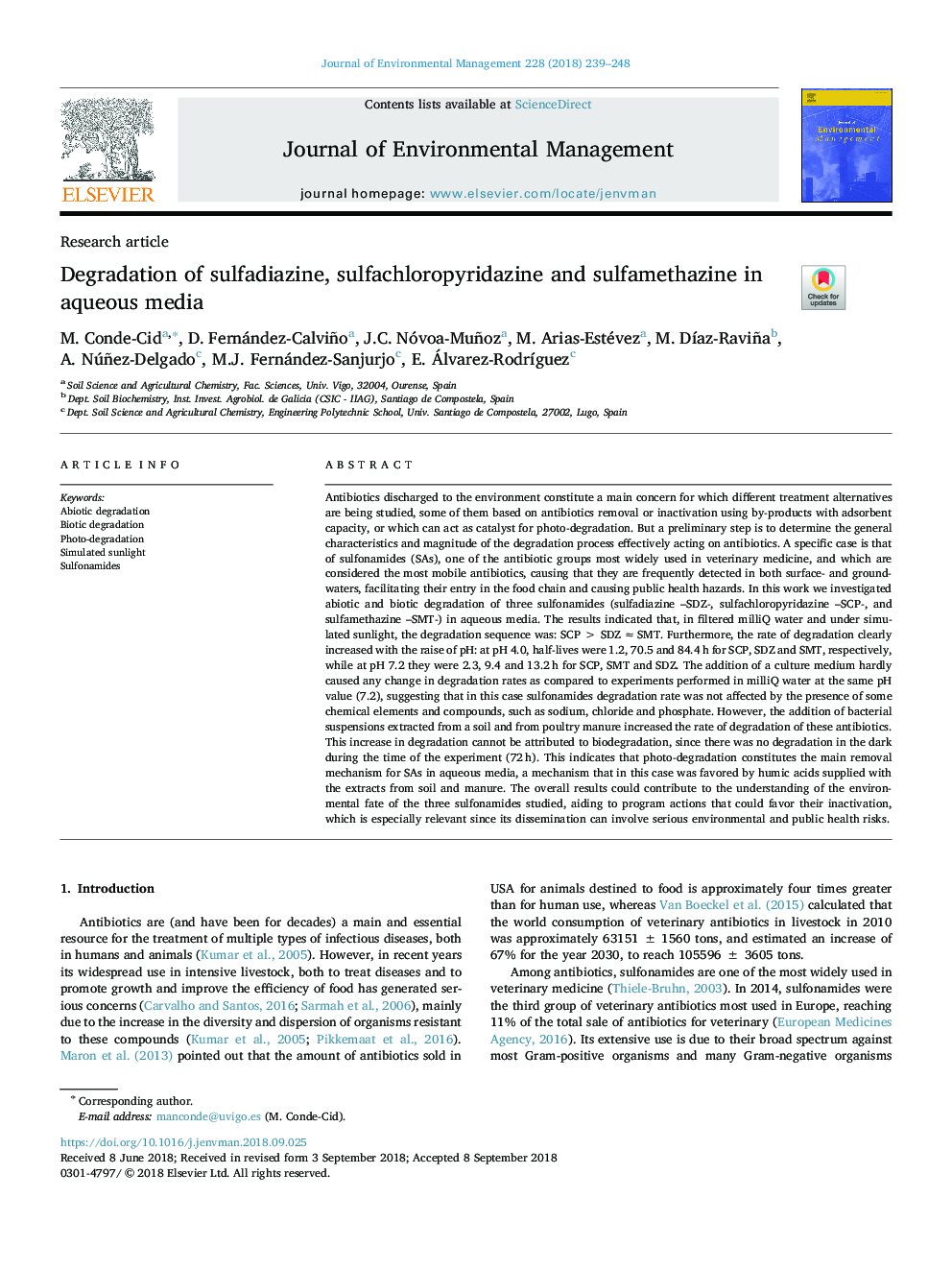| کد مقاله | کد نشریه | سال انتشار | مقاله انگلیسی | نسخه تمام متن |
|---|---|---|---|---|
| 10149055 | 1646715 | 2018 | 10 صفحه PDF | دانلود رایگان |
عنوان انگلیسی مقاله ISI
Degradation of sulfadiazine, sulfachloropyridazine and sulfamethazine in aqueous media
ترجمه فارسی عنوان
تجزیه سولفادیازین، سولفاکلروپیریدازین و سولفاماتازین در محیط های آبی
دانلود مقاله + سفارش ترجمه
دانلود مقاله ISI انگلیسی
رایگان برای ایرانیان
کلمات کلیدی
تخریب ابیوتیک، تخریب زیستی، تخریب عکس، شبیه سازی نور خورشید، سولفونامیدها،
موضوعات مرتبط
مهندسی و علوم پایه
مهندسی انرژی
انرژی های تجدید پذیر، توسعه پایدار و محیط زیست
چکیده انگلیسی
Antibiotics discharged to the environment constitute a main concern for which different treatment alternatives are being studied, some of them based on antibiotics removal or inactivation using by-products with adsorbent capacity, or which can act as catalyst for photo-degradation. But a preliminary step is to determine the general characteristics and magnitude of the degradation process effectively acting on antibiotics. A specific case is that of sulfonamides (SAs), one of the antibiotic groups most widely used in veterinary medicine, and which are considered the most mobile antibiotics, causing that they are frequently detected in both surface- and ground-waters, facilitating their entry in the food chain and causing public health hazards. In this work we investigated abiotic and biotic degradation of three sulfonamides (sulfadiazine -SDZ-, sulfachloropyridazine -SCP-, and sulfamethazine -SMT-) in aqueous media. The results indicated that, in filtered milliQ water and under simulated sunlight, the degradation sequence was: SCPâ¯>â¯SDZâ¯ââ¯SMT. Furthermore, the rate of degradation clearly increased with the raise of pH: at pH 4.0, half-lives were 1.2, 70.5 and 84.4â¯h for SCP, SDZ and SMT, respectively, while at pH 7.2 they were 2.3, 9.4 and 13.2â¯h for SCP, SMT and SDZ. The addition of a culture medium hardly caused any change in degradation rates as compared to experiments performed in milliQ water at the same pH value (7.2), suggesting that in this case sulfonamides degradation rate was not affected by the presence of some chemical elements and compounds, such as sodium, chloride and phosphate. However, the addition of bacterial suspensions extracted from a soil and from poultry manure increased the rate of degradation of these antibiotics. This increase in degradation cannot be attributed to biodegradation, since there was no degradation in the dark during the time of the experiment (72â¯h). This indicates that photo-degradation constitutes the main removal mechanism for SAs in aqueous media, a mechanism that in this case was favored by humic acids supplied with the extracts from soil and manure. The overall results could contribute to the understanding of the environmental fate of the three sulfonamides studied, aiding to program actions that could favor their inactivation, which is especially relevant since its dissemination can involve serious environmental and public health risks.
ناشر
Database: Elsevier - ScienceDirect (ساینس دایرکت)
Journal: Journal of Environmental Management - Volume 228, 15 December 2018, Pages 239-248
Journal: Journal of Environmental Management - Volume 228, 15 December 2018, Pages 239-248
نویسندگان
M. Conde-Cid, D. Fernández-Calviño, J.C. Nóvoa-Muñoz, M. Arias-Estévez, M. DÃaz-Raviña, A. Núñez-Delgado, M.J. Fernández-Sanjurjo, E. Álvarez-RodrÃguez,
